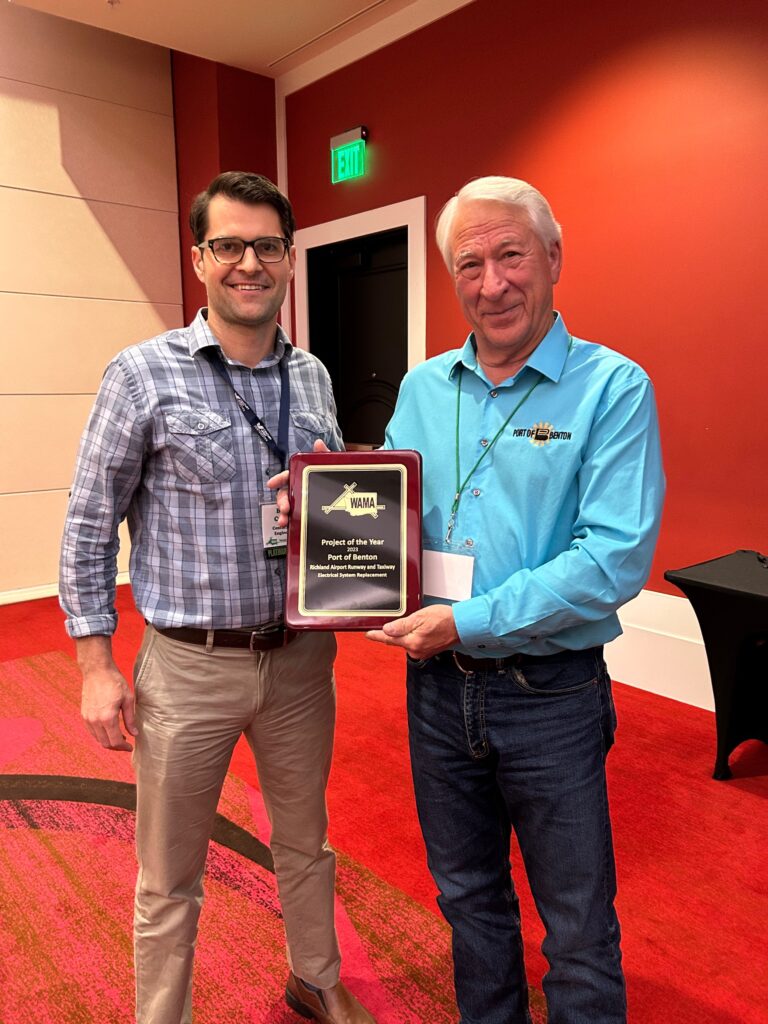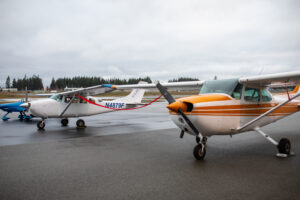An Interview with Bryan Condon, PE, Project Manager. Join us as Bryan shares the challenges, successes, and valuable lessons learned from this project that earned the Washington Airport Management Association Project of the Year Award. Discover the power of collaboration and communication that enhanced safety and reliability for pilots and the community.
Q: Congratulations on winning the Washington Airport Management Association Project of the Year Award! Were you surprised at the win?
Bryan: I was beyond surprised. I had actually stepped out to use the restroom when they announced it. When I came back, they were waiting for me and the client (who has also stepped away). I didn’t expect this project to win because I thought a project of the year would be something more… technically exciting, I guess. However, I later learned that the emphasis was on the communication with the pilots regarding the interruptions to the runways.

Q: Can you tell us about the 1Benton Richland Airport Runway & Taxiway Electrical Replacement project and its significance?
Bryan: This project involved replacing all the electrical equipment at the airport, including edge lights, taxiway lights, guidance signs, and navigation aids (including PAPIs, REILs, and wind cones). The existing electrical system was deteriorated and unreliable, there’s often be outages. We also installed a backup generator. It was a full overhaul of the electrical components. Due to FAA safety requirements, because the work was essentially at the edge of the pavement, we had to close both runways for extended periods to allow for the work. The phasing plan was very complex to ensure that at least one runway was available for pilots throughout the project. There was a ton of coordination between our inspection staff, the contractor, and the Port of Benton. We were meeting on a weekly basis to talk through the schedule, then confirming closures to the Port’s communications staff so they could relay it to the tenants and the public in general. It was a major overhaul to enhance safety and reliability, but the phasing and communication was the most significant part of this project.
Q: What were the main challenges and complexities involved in the electrical system?
Bryan: Besides the phasing plan, the main challenge was dealing with an electrical system that was over 20 years old. We didn’t know what we would find when the contractor started the work. We encountered direct buried cables where we expected conduit. We worked with the contractor, the Port of Benton, and the FAA to address these nonstandard practices and made changes accordingly. It was challenging because we didn’t know what surprises each week would bring.
Q: What did you do to minimize disruptions to airport users and nearby neighborhoods and businesses?
Bryan: With the primary runway closed for over a month, all aircraft had to use the secondary runway, which flew over a residential area more frequently. We coordinated with the Port of Benton to provide information about the duration and reasons for the increased air traffic over the neighborhood. They sent mailers and used social media and newsletters to inform the community about the project and its impact.
Q: Communication played a crucial role in the success of this project. How did you and your team approach the task of providing regular updates and engaging with the public throughout the project?
Bryan: The Port of Benton, our client, was proactive in public outreach, which was a pleasant surprise. That’s not the case with every client. I’ve seen runway closure projects that have resulted in tension and resentment from a lack of communication with the public. We had regular check-ins to discuss the project’s progress. Their dedicated communication team ensured the information was relayed to the tenants and the public. It really helped to create a positive perception of the project and helped us maintain good communication with the pilot community.
Q: In what ways did the Port of Benton demonstrate effective planning and phased closures to ensure the safe and timely completion of the project?
Bryan: During the design phase, we collaborated with the Port of Benton to develop a phasing plan. There was a lot of back and forth, it was an iterative process. We explained the trade-offs between complexity, duration, and cost. They understood the implications and we found a balance that met their needs. Not everything moved like clockwork. Especially electrical, it would get opened up and look different than expected, then more time was needed for that phase. Regular communication between contractor, engineer, and client allowed us to adapt as needed and maintain safety and timeliness.

Q: Can you highlight any innovative strategies or technologies employed during the project to improve efficiency or minimize disruptions?
Bryan: Surprisingly, we didn’t employ any innovative strategies or technologies. We relied on basic consulting principles, such as identifying the client’s needs, anticipating them during construction, and regular check-ins. Sometimes, the most effective approaches are the simplest ones.
Q: How did you manage coordination and collaboration among different stakeholders to ensure a smooth execution of the project?
Bryan: I’d say we relied on Century West developed standards and templates for those weekly check-ins with all stakeholders. Conversations that would inform us of what the next week or two would look like. We’d then work closely with the client’s communication team to relay relevant information to the public.
Q: What were some of the key lessons learned from this project that could be valuable for future airport infrastructure projects?
Bryan: The key lesson I learned is the importance of communication and being open to revising or adjusting plans to meet the project’s specific needs and the client’s expectations. Every project and client is unique, so it’s crucial to adapt accordingly. It can be tempting to use a one-size-fits-all approach. You know, a model that I’ve used for 15 years, that I know is proven at these other airports, but understanding the client’s specific requirements and tailoring the project accordingly is vital to a truly successful project.
Q: Winning the WAMA Project of the Year Award is a significant accomplishment. What does this recognition mean for you and your team at Century West Engineering?
Bryan: Winning this award reassures us that we are doing a good job for our clients. It validates our commitment to delivering successful projects and meeting the needs of our clients.
Q: Looking back at the project, what are you most proud of, and why?
Bryan: I’m most proud of how the wider team, including Century West, the contractor, and the Port of Benton, came together to transform federal funding into improved infrastructure for the pilots. We accomplished this with minimal disruptions and impacts to pilots. The collaboration and utilization of different skill sets led to the project’s success. It’s a proud moment to see teamwork making a positive difference.







